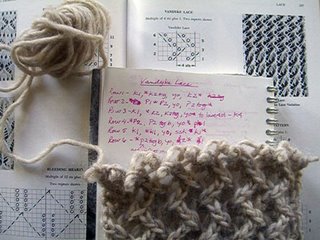 |
| Published in 1993 |
In the post-1960s upsurge of serious attention to the history of the Bauhaus, the Weaving Workshop has received little attention, says the introduction. "It has had two strikes against it: in the hierarchy of art and design, textiles and women share equally low positions. Moreover, like women, textiles have equally been cast in the supportive role: one notices the chair, but not the cover."
"More than 75 contemporary artists" (some are pairs of collaborators) choose an influential work by another artist to write about. The book includes these women artists, many of whom were new to me:
Lots of food for thought here. I could have spent a day copying down great chunks... but it's due back at the library.
It was the cover and the pithy wit of the introduction (2004) that attacted me, in the charity shop, so it came home. Unfortunately the story (1983) wasn't up to the introduction, or the wit had worn thin. Back to the shop it goes.
 Sometimes you buy a book to give as a present, and it doesn't leave your hands. On dipping into Dava Sobell's "The Glass Universe", I was gripped by the storytelling. It's "the hidden history of the women who took the measure of the stars" - they were called "computers" because of the calculations they did; they worked at Harvard's astronomical observatory, and by extension the book is a history of the observatory itself and of developments in astronomy in the decades either side of 1900. Highly recommended, even if you don't know Betelgeuse from Polaris, or what a spectroscope is (a woman is important in that, too).
Sometimes you buy a book to give as a present, and it doesn't leave your hands. On dipping into Dava Sobell's "The Glass Universe", I was gripped by the storytelling. It's "the hidden history of the women who took the measure of the stars" - they were called "computers" because of the calculations they did; they worked at Harvard's astronomical observatory, and by extension the book is a history of the observatory itself and of developments in astronomy in the decades either side of 1900. Highly recommended, even if you don't know Betelgeuse from Polaris, or what a spectroscope is (a woman is important in that, too).
 |
| First published in 1944 |
"Temple spent most of the following morning delving into the files of the Egyptologists' Journal ... This ;monthly publication, published from an obscure address near the ritish Museum, presented a most forbidding appearance to any layman not interested in its particular subject, with its severe buff colour, endless pages of small print and very dull pictures rather indifferently reproduced.
"Somewhat to his surprise, Temple found the two articles by Sir Felix Raybourn countained an occasional flash of whimsical humour to relieve their rather erudite discourse. Both concerned a series of excav ations undertaken by Sir Felix, which, as far as Temple could see, had proved singularly unproductive save for a few ancient weapons in very poor condition, and a vessel containing a strange liquid which had not been analysed. Sir Felix dilated at some length upon the medicines of ancient Egypt and the cures they were reputed to have effected, and thus hecleverly concealed the paucity of the actual results of his expedition. As a writer himself, Temple admired the ingenious manner in which Sir Felix had contrived this little deception."As someone familiar with the world of academic journals through working as librarian and editor, I found that passage most amusing, and admired Durbridge's dexterity in avoiding the potentially confusing "he" in the second paragraph.
 |
| 2012; "152 illustrations, 135 in colour" |
Tomma Abts
Eija-Liisa Ahtila - https://www.mariangoodman.
Eleanor Antin - american performance artist - https://www.moma.org/
Vija Celmins
Spartacus [now Monster] Chetwynd - https://www.tate.org.uk/art/
Tacita Dean
Marlene Dumas
Katharina Fritsch - http://whitecube.com/
Susan Hiller
Candida Hoefer - german photographer of empty interiors - http://www.artnet.com/
Cristina Iglesias
Annette Messager
Beatriz Milhazes - brazilian; painting, drawing, collage - https://whitecube.com/
Cornelia Parker
Sophie Ristelhueber - french photographer of territory and effects of war - https://www.moma.org/
Gillian Wearing
Rachel Whiteread
Lots of food for thought here. I could have spent a day copying down great chunks... but it's due back at the library.
 |
| Virago Classic "with an introduction by the author" |












 More recently, Gloria Petyarre has been painting Bush Medicine Dreaming -
More recently, Gloria Petyarre has been painting Bush Medicine Dreaming -



























































